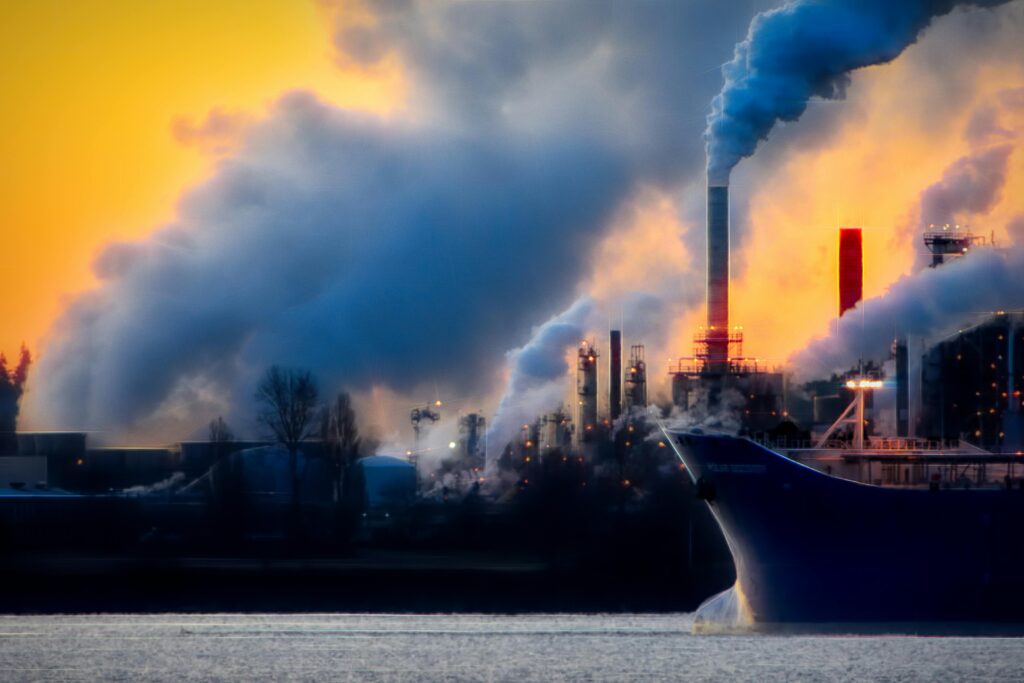Chapter 12 of Class 8 Science (Oxford Book) explores the fascinating world of Sound—its production, propagation, and properties. This chapter explains how sound travels through different mediums, how we hear sound, and concepts like pitch, frequency, and amplitude. The solutions provided here offer clear and concise answers to all textbook questions, helping students understand the topic better and prepare effectively for exams.

Class 8 Science Pollution of Air and Water Oxford
II. Very short answer type questions
A. Give one word for the following.
1. The presence of chemicals in the air in quantities harmful to human health and the environment.
Answer: Pollution
2. Entrapment of solar radiation by Earth’s atmosphere.
Answer: Greenhouse Effect
3. Unnatural increase in the Earth’s surface temperature.
Answer: Global Warming
4. Air pollutants responsible for the depletion of the ozone layer.
Answer: CFCs (Chlorofluorocarbons)
5. Washing away of fertilizers into the water bodies.
Answer: Leaching
6. Overgrowth of plants on the surface of water bodies due to nutrient enrichment.
Answer: Eutrophication
III. Short answer type questions
How is greenhouse effect responsible for global warming?
Answer:
The greenhouse effect happens when gases like carbon dioxide trap heat from the Sun in Earth’s atmosphere. This trapped heat raises the Earth’s temperature, leading to global warming, which causes changes in climate and weather patterns.
2. How is acid rain formed? Write any two effects of it.
Answer:
Acid rain forms when gases like sulphur dioxide and nitrogen oxides mix with rainwater and fall to the Earth as acidic rain.
Effects of acid rain:
- It damages trees and plants by harming their leaves.
- It pollutes lakes and rivers, killing fish and aquatic life.
3. Write any two effects of air pollution on plants and animals.
Answer:
- Air pollution can damage the leaves of plants, reducing their ability to make food.
- Animals and humans may suffer from breathing problems like asthma and lung diseases due to polluted air.
4. List any two effects and prevention methods of water pollution.
Answer:
Effects of water pollution:
- It kills fish and other aquatic animals.
- Polluted water causes diseases in humans.
Prevention methods:
- Avoid dumping chemicals and waste into rivers and lakes.
- Use eco-friendly products and treat sewage before releasing it into water bodies.
5. Discuss how inorganic pesticides and chemical fertilizers are responsible for water pollution.
Answer:
Inorganic pesticides and chemical fertilizers used in farming can wash off into nearby rivers and lakes during rains. These chemicals pollute the water, killing fish and other aquatic life. They also make the water unsafe for drinking and other uses.
IV. Long answer type questions
Discuss the common air pollutants with their main sources.
Answer:
Common air pollutants and their main sources are:
- Carbon monoxide (CO):
Produced by incomplete burning of fuels like petrol, diesel, and wood. It is harmful because it reduces oxygen transport in the blood. - Sulphur dioxide (SO₂):
Released from burning coal and oil, especially in factories and power plants. It causes acid rain and respiratory problems. - Nitrogen oxides (NOx):
Produced during high-temperature burning in vehicles and industries. They contribute to smog and acid rain. - Particulate matter:
Tiny dust and smoke particles from construction, burning of fuels, and factories. They cause breathing difficulties. - Chlorofluorocarbons (CFCs):
Found in refrigerants and aerosol sprays. They damage the ozone layer, which protects Earth from harmful UV rays.
2. Explain the process of distillation with the help of a diagram.
Answer:
Distillation is a process used to separate a mixture of liquids with different boiling points.
Steps:
- The liquid mixture is heated in a flask.
- The liquid with the lower boiling point evaporates first and turns into vapor.
- The vapor passes through a condenser where it cools and turns back into liquid.
- This liquid is collected in a separate container, called the distillate.
- The process continues until all the components are separated.
Uses:
Distillation is used to purify water, separate alcohol from water, and in chemical industries.
Diagram Description:
3. Describe the various methods used for purification of water at home.
Answer:
At home, water can be purified using several simple methods:
- Boiling:
Boiling water kills harmful germs and bacteria, making it safe to drink. - Filtration:
Passing water through a cloth or a filter removes dirt and large particles. - Using Water Purifiers:
Water purifiers use different techniques like activated carbon, UV light, or RO (Reverse Osmosis) to remove impurities. - Sedimentation:
Letting water stand undisturbed so that heavy particles settle at the bottom, and then the clean water is poured off. - Chlorination:
Adding a small amount of chlorine kills harmful microbes in water (used in large-scale treatment).
Class-wise Solutions
Class 12:
Class 12 Physics – NCERT Solutions
Class 12 Chemistry – NCERT Solutions
Class 11:
- Class 11 Physics – NCERT Solutions
- Class 11 Chemistry – NCERT Solutions
- Class 11 Biology – NCERT Solutions
- Class 11 Math – NCERT Solutions
Class 10:
Class 9:
Class 8: Class 8 Science Pollution of Air and Water Oxford & NCERT Solution- Explore
Class 7:
Class 6:
Subject-wise Solutions
Physics:
Chemistry:
Biology:
Math:
- Class 11 Math – NCERT Solutions
- Class 10 Math – NCERT Solutions
- Class 9 Math – NCERT Solutions
- Class 8 Math – NCERT Solutions
Science:
- Class 10 Science – NCERT Solutions
- Class 9 Science – NCERT Solutions
- Class 8 Science – Oxford Solutions
- Class 7 Science – Oxford Solutions
- Class 6 Science – Oxford Solutions
NEET BIOLOGY
- Evolution
- Breathing and Exchange of Gases
- Anatomy of Flowering Plants
- Body Fluids and Circulation
- Human Health and Disease
- Microbes in Human Welfare
- Cell Cycle and Cell Division
- Biotechnology and Its Applications
- Biodiversity and Conservation
- Morphology of Flowering Plants
For the official Class 8 Mathematics Solutions, you can visit:
- NCERT Textbooks (for Class 8):
Understanding environmental issues is crucial, and Class 8 Science Pollution of Air and Water Oxford helps students build a strong foundation in this area. The chapter explains the causes, effects, and preventive measures related to pollution in a clear and engaging manner. Through real-life examples and well-structured exercises, Class 8 Science Pollution of Air and Water Oxford encourages students to think critically about their role in protecting the environment. With these solutions, learners can better grasp key points from Class 8 Science Pollution of Air and Water Oxford and improve their exam readiness. Overall, the Class 8 Science Pollution of Air and Water Oxford chapter is essential for building awareness and responsibility toward a cleaner, healthier planet.
